How Steeple Sinderby Wanderers Won the F.A. Cup
This is Carr's fourth novel. It is based on his personal experience of playing for a very succesful local football team called South Milford White Rose, during a year he spent in 1930-31 as a teaching assistant between leaving Castleford Secondary School and going to Dudley Training College for Teachers
Carr's second novel A Season in Sinji was published by Alan Ross. According to a letter from Carr to Ross in January 1974, seen at Leeds University, Ross had refused the third novel, The Harpole Report, because it was 'too academic'. Carr sent Ross the opening third of Steeple Sinderby in February 1974 and Ross agreed to publish it under the imprint London Magazine Editions. The last page of the novel is dated Botley, 1974
. (Carr played football for Botley, a village just outside Southampton, when he taught at a school in Bitterne between 1934 and 1935). Carr signed a contract for the novel in April 1975 and it was published a month later. Although it is said that each of Carr's novels had a different publisher, except for the two he published himself, in effect Alan Ross published two of Carr's novels, one about cricket and one about football.
The novel was adapted for the stage by Christopher Lillicrap and Mike Fields and performed in September 1989 at the Swan Theatre, Worcester and later at the Mermaid Theatre, London in March 1990 (see Dramatisations).
The novel was read on BBC Radio 4 Book at Bedtime
in October-November 1981. The BBC web site does not record who read it.
(Last updated on 14/3/2023)
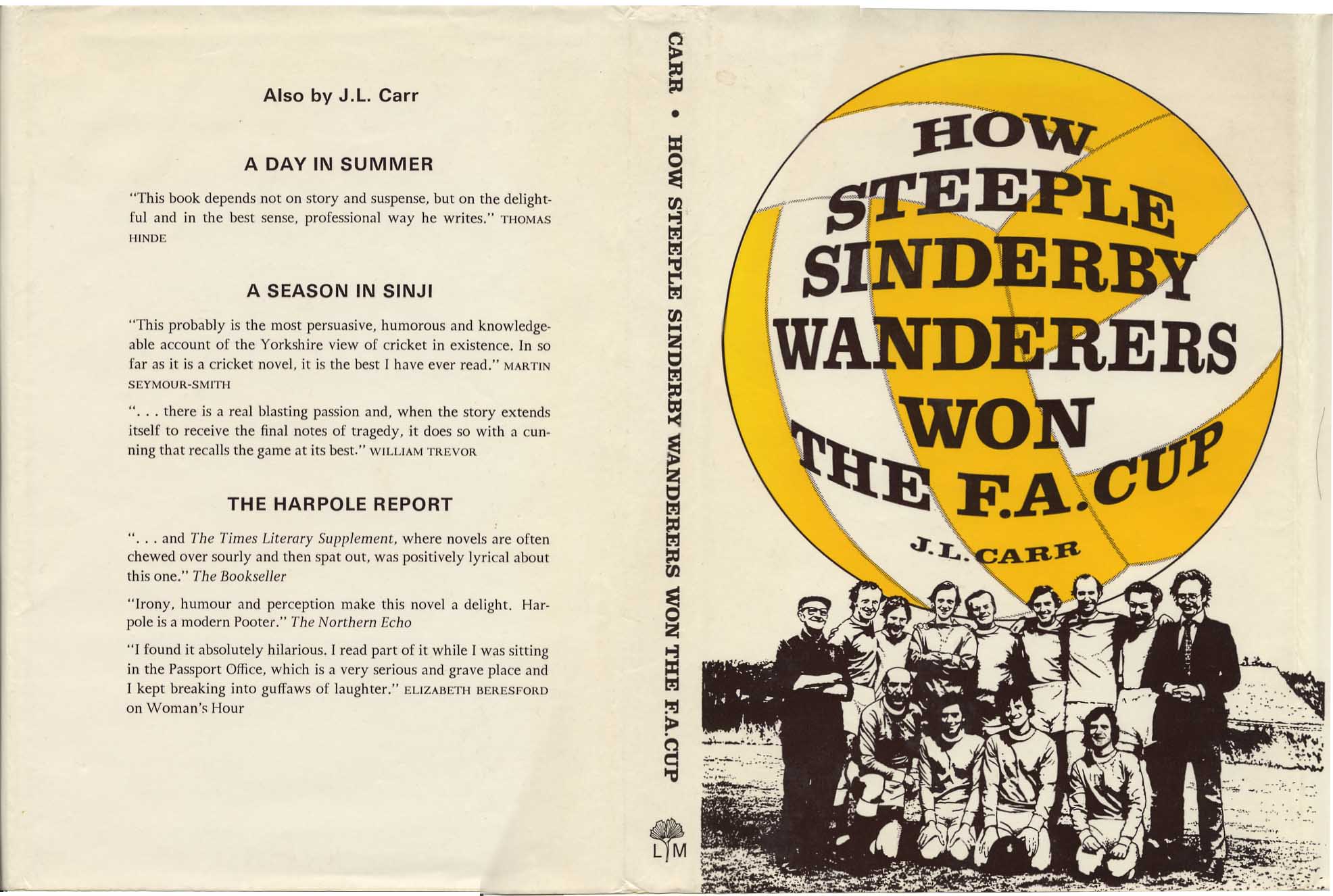
Dust jacket of first edition, first impression
● First edition, first impression
Publisher: London Magazine Editions
Date of publication: May, 1975
ISBN: 904388 02 6
Size: 223 x 154 mm.
Pagination: two free endpapers, half title, title page, quotations and dedication, 124 pp, 4 blank pages, free endpaper
Endpapers: decorated with a photograph in yellow on black of six men playing football
Binding: Brown cloth; author, title and publishers logo vertically in gold on spine
Dust jacket design: Humphrey Stone
Designed and printed by: The Compton Press Ltd., Compton Chamberlayne, Salisbury, Wiltshire
Price: £2.50
Copies sold, including second impression: 2,164 (Rogers, 2003)
Royalties: £539 (Rogers, 2003)
Dedication: FOR BOB and for those others of my generation who have shivered into their kit behind hedgerows and in ditches
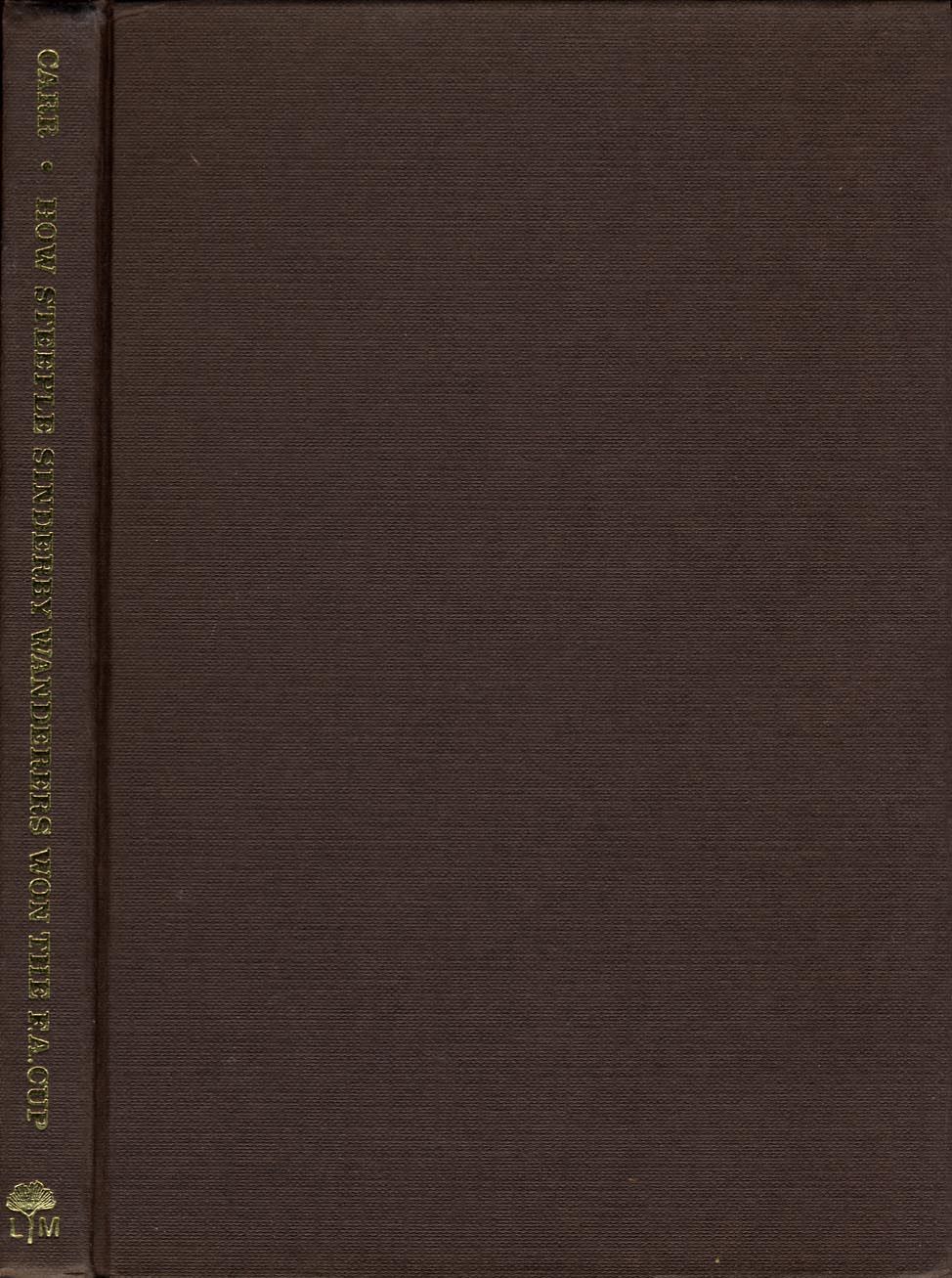
Front panel and spine of cover
Front fold-in: And why not? Haven't you always wanted it to happen?
Sometimes it does. David beat Goliath, the Revenge took on 53 galleons, Hambledon Cricket Club thrashed All-England.
This is a draft report by the Secretary of how a village football team faltered through to the First Round Proper of the F.A. Cup, then staggered on from utter obscurity to scorching celebrity. As he says, What happened happened because three - well, mabybe, four - remarkable men were at the same place at the same time. Which, when you come to think about it, is why most unusual things happen.
The theme is football, but it's also about contemporary Britain and rural life. Above all, it's about people. It's funny, exciting and impossible to put down.
J.L.Carr is the author of such successful books as A Season in Sinji and The Harpole Report. He lives in Kettering where he publishes a series of architectural/historical maps of the English counties.
Notes: In the correspondence with Alan Ross about the book held by Leeds University Archive is a letter in which Carr wrote:
The cover... Well, I'll tell you one thing I would like and it might get it more widely reviewed since it seems reviewers are faced by a bewildering heap of books in the office cupboard and, after they picked out the Amis's and Braines, Murdochs and Hills, they just have a lucky dip at what's left. I'd like a selection of review quotes of the first three novels on the back. There are some good ones from The Times Lit., Thomas Hinde, Wm Trevor and Martin Seymour-Smith and these might encourage reviewers to at least have a look at it and so get some free advertising of the novel.
A variant of the book has the football on the half-title printed again, in reverse, over the list of other titles by the same author on the other side of the half-title, and the quotations also printed in reverse over the dedication. It loks like a counterproof, in which the wet ink has tranferred in reverse onto the facing sheet.
Inscriptions:
In an inscription in a copy of this book Carr explained how the dust jacket was achieved:
The team on the jacket are the printers of the book. The owner is young man in specs whose dad owns a sort of castle near Salisbury & who persuaded his printing staff to turn out in kit to save paying models.
Carr wrote inside other copies seen of this book:
I hope you enjoy this. I take it seriously (if no one else does).
Tom,* remembering furious encounters in the Rushby Pastures, the meadow behind the Popplewells house, the Welfare field and that big slope at Tadcaster! As well as up the middle of the village street with a pigs bladder from Walter Wainwright’s... I played one season in Barkston Ash, when I did a year uncertif at Milford, when I was 18, & we reached the final against Halton, played at Garforth. We were winning 2-0 ten minutes from time when fighting broke out, spreading from the players to the spectators, some of whom rooted up the stakes driven in to surround the pitch & attacking each other with them. So instead of climbing on the flat cart (as I’d hoped) to receive my medal, we were furtively given them by Walter Osborne in the bar of the pub (which tainted the prize for a Methodist!!). So I never had my hour of glory... Lloyd
Why was it written? Well, partly because I wondered if a serious novel could be written about this widespread activity. So why football? Partly because of the fun of making such a feat plausible, or trying to, and partly because I like exercising the East Riding tongue.
* Tom is Carr's brother-in-law, Tom England, who married Kathleen (Kathie), Carr's elder sister. Tom England was also a teacher. Carr was known to his family as Lloyd, his given middle name, and he signed his letters to them using this name.
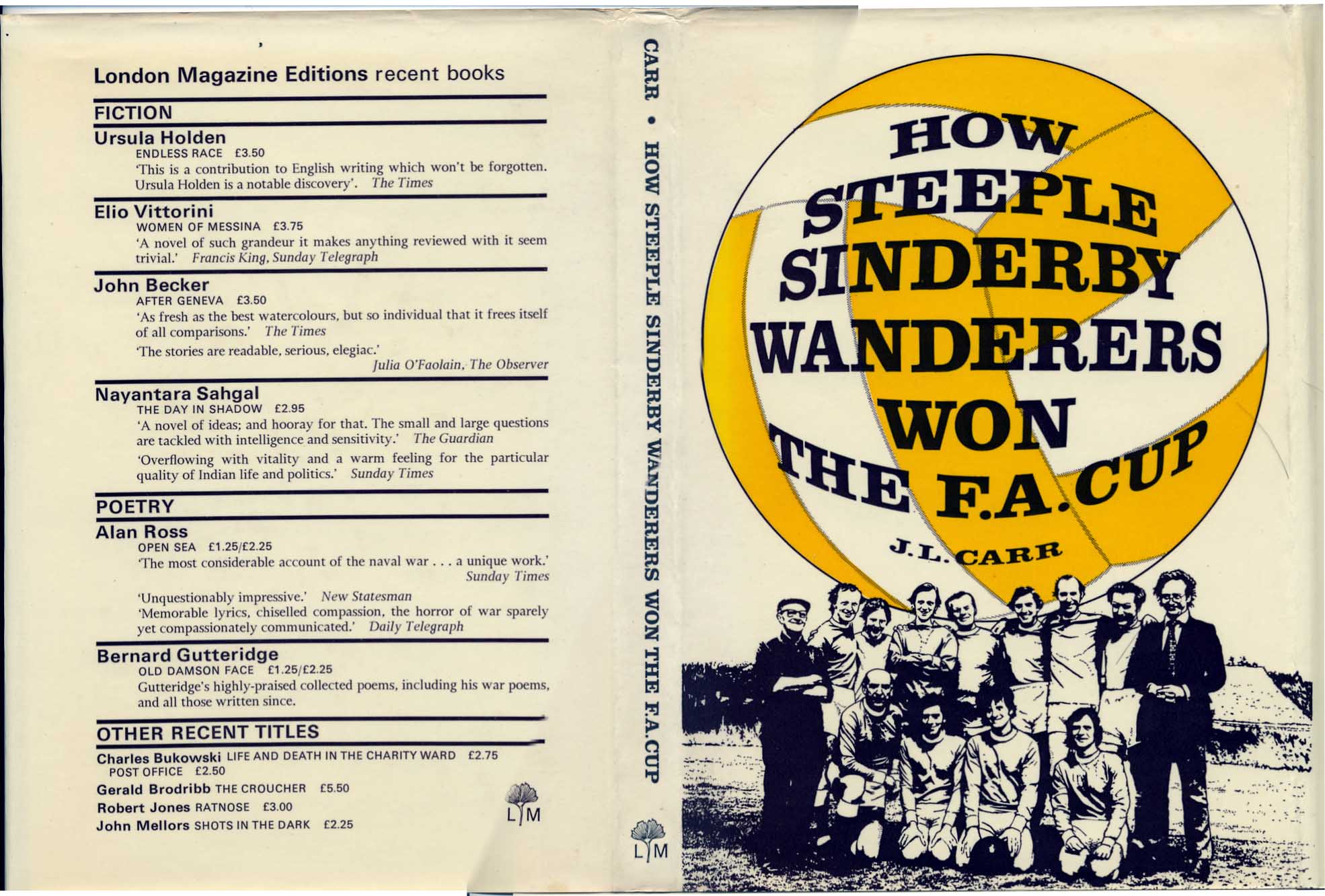
Dust jacket of first edition, second impression
● First edition, second impression
Publisher: London Magazine Editions
Date of publication: Second impression 1975
ISBN: 904388 02 6
Size: 223 x 154 mm.
Pagination: two free endpapers, half title, title page, quotations and dedication, 124 pp, 4 blank pages, free endpaper
Endpapers: plain white, undecorated
Binding: Brown cloth; author, title and publishers logo vertically in gold on spine
Dust jacket design: Humphrey Stone
Designed and printed by: The Compton Press Ltd., Compton Chamberlayne, Salisbury, Wiltshire
Price: £2.95
Dedication: FOR BOB and for those others of my generation who have shivered into their kit behind hedgerows and in ditches
Front fold-in: Same as first impression but states Second Impression
above the name of the publisher.
Notes: The second impression has reviews of other books published by London Magazine Editions on the rear of the dust jacket, rather than reviews of Carr's previous novels. There are no decorated end-papers and the price was 45 pence higher, at £2.95. This is rarer than the first impression; it is likely that only about 300 copies were printed.
In late 1976 Carr wrote to Alan Ross to say that he would have the 140 remainders, and would call to collect them. He also wrote:
May I say – in parting – how pleased I have been with your stylish productions of both Steeple Sinderby and, earlier a A Season in Sinji. The appearance of a book is an important thing with me and these have more than fulfilled my hopes.
In another letter, dated 21st December 1976, the reason for the parting was explained:
I really do feel I must move on to a publisher with his own selling and publicity division, in order (as they say) to better myself. Unfortunately, writing is partly my living. But I'm glad it was you who published the cricket and football novels. I think both of us see more in a game that meets the eye and I'm sorry we didn't meet more often.
Ross kept in touch with Carr, who responded to a letter, probably in 1981 (Carr didn't add the date to many letters once correspondence had been established):
Thank you for writing. No, I think I read somewhere that you had given up book publishing. Well 'A Month in the Country' has all the signs of creative atrophy do you know it. It was a cobbled up job but, mercifully, the seams don't show. 'A Season in Sinji' was the best of the lot and, some day, it will come into its own. But 'A Month' deserved the prize of being a love story without even a Cartland kiss on the brow! Though, oddly enough, a Cambridge parson's wife declares it to be "oozing with sex".
● Second edition
Publisher: Grafton Books, London
Date of publication: March 1986
ISBN: 0586063587
Size: 177 x 111 mm
Pagination: 6 pp prelims, 122pp
Binding: printed card wrappers
Cover design: Geo Parkin
Price: UK £1.95, New Zealand $8.95, Australia $5.95
Printed by: Collins, Glasgow
Notes:
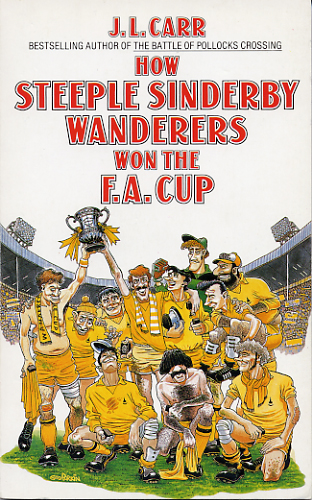
Front cover
● Third edition, first impression
Publisher: Quince Tree Press, 27 Mill Dale Road, Kettering
Date of publication: 4th February 1993
ISBN: 0 900847 94 8
Size: 197 x 130 mm
Pagination: 6 pp prelims including foreword, pp 124
Binding: printed thick card wrappers
Cover illustration: John Lawrence
Printed by: Stanley L. Hunt (Printers) Ltd, Rushden, Northamptonshire
Price: £4.95
Copies printed: 2,000
Reprinted: still in print and available from The Quince Tree Press
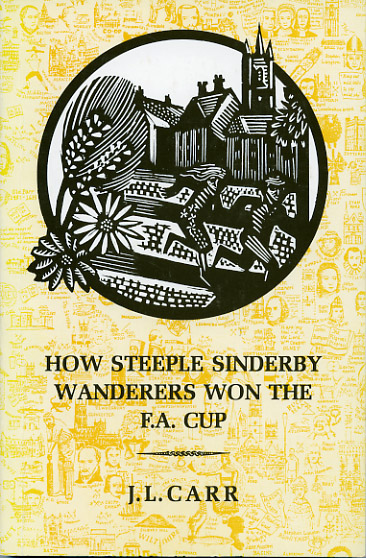
Front cover
Notes: This is the second or third novel that Carr republished himself, after A Month in the Country. Carr stated on the title page that this was the fourth book published by the Quince Tree Press, but he also wrote the same inside the edition of Pollocks Crossing. They were both published in February, 1993. These were the last novels that Carr republished before his death in February 1994 so, unlike the two original novels that he published himself, signed copies are uncommon. It has the smallest edition of his self-published novels.
An inscription in a copy seen on the Internet reads: 'For [name removed] on its first day of re-publication as non-fiction, JLC 1993 Feb 4'.
More information about later impressions and foreign language editions can be found on the Wikipedia page for this novel.